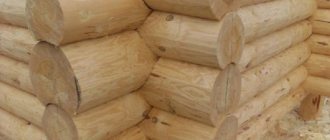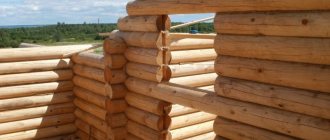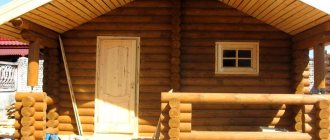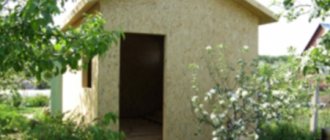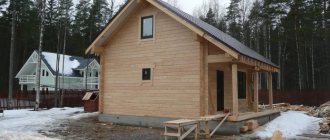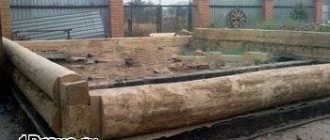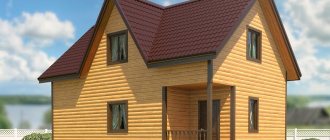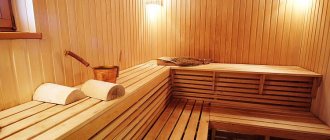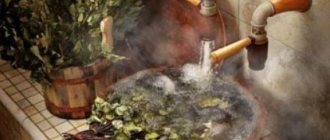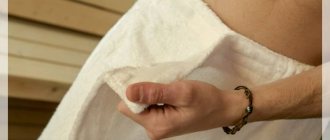The benefits of bath procedures are undeniable, but often, having seen the price of ready-made bathhouse projects made of timber, many people refuse to build one on their site. But this does not mean that you do not have the opportunity to become the owner of your own bathhouse. There is a solution - to build a bathhouse yourself, without resorting to the help of specialists.
Baths made of planed timber
Among the main types of timber are the following:
- non-profiled: classic timber, which is made from solid wood, has smooth edges;
- profiled: the edges have special grooves that connect to a similar beam;
- carriage or half-beam - two opposite sides are cut from the log, and the rest remain semicircular;
- laminated veneer lumber is a load-bearing structure that is 50-70 percent stronger than solid wood.
A bathhouse made of timber is made from solid wood by sawing. This material is used most often for the construction of baths. The diameter of the logs is from 150 to 250 mm, softwood is used. Among the most popular are pine, larch, fir, and cedar. Hardwoods can also be used: oak, birch, aspen, linden.
Among the main advantages are:
- availability;
- affordable cost;
- storage of the form, which avoids shrinkage, cracks and other wood defects;
- environmental friendliness;
- resistance to temperature changes and exposure to sunlight;
- high resistance to moisture, good thermal insulation properties;
- wide functionality: timber can be used for load-bearing structural elements.
The disadvantages of the products are:
- the possibility of cracks appearing on the visible surface of the timber during shrinkage;
- it is necessary to cover the walls outside and inside, and this increases the cost of finishing work;
- the structure can experience serious shrinkage - up to 10-15 cm.
When choosing such structures, you should pay attention to the humidity level. It is advisable to use only timber that is dried in a heat chamber.
Recognized advantages and disappointing disadvantages of a log bathhouse
Bathhouse made of laminated veneer lumber
Deadlines. To build a log bathhouse from timber, it takes from 2 to 7 weeks. These are average statistics for a neat small bathhouse. The start-up period after assembly of the building depends on humidity.
Shrinkage. Depends on the material. Glued gives the smallest (1-2%). Profiled and dried, up to 5%, with natural humidity, up to 10%;
Labor intensive. When using profile timber, there is an option to build the “desired house” yourself, without involving competent builders. Well, let’s say in a company of 3 people, plus the necessary tools and available mechanisms.
Finishing. Again, it depends on the type of timber. If you use a profiled one, finishing is generally not needed. If you build it from ordinary non-core material, you will have to spend money not only on finishing, but also on caulking.
Log
Deadlines. With similar dimensions, a log bathhouse can be built in the same time. This is provided that the logs are already ready. However, you will have to wait about a year for the “ribbon cutting” with a broom under your arm.
Shrinkage. On average, over a year, the log house will “sag” by 8 - 12%
Labor intensive. It is not easy to build a bathhouse without qualified builders or an experienced consultant. There are moments, ignorance of which leads to bad consequences.
Finishing. You need caulking (more than once) plus sanding.
A chopped log steam room pampers its owners with natural harmony and fabulous charm. What material is it made from? Well, as a rule, from coniferous wood - larch, pine, spruce or cedar. To make it clearer which sauna is better, now we will consider all the advantages of a log sauna.
- Durability. A properly made log steam room can last a hundred years. No, no, I'm not exaggerating.
- Wear resistance. The people's health resort is a fearless lady. She is not afraid of temperature changes, stress, or uninvited guests - rodents, insects, microorganisms, or precipitation.
- Low thermal conductivity. The steam room heats up very quickly and retains heat for a very long time.
- There is no need for facing materials. The log structure, as already mentioned, is attractive, which means that finishing is not required.
- Beauty. The log sauna is very beautiful. Looking at it, you get the feeling that it came down from the marvelous paintings of famous artists.
- Invaluable benefit. Conifers, when exposed to high temperatures and humidity, release substances that have a beneficial effect on the human body.
- Heady smell. Wood, when heated, gives an amazing aroma, rewarding every person with invaluable health.
- Easy installation (for a specialist). Thanks to the presence of grooved components, the structure is assembled quickly and easily.
- Relatively reasonable price. The construction of a bathhouse from aromatic logs will cost approximately $150.
Well, still, which bathhouse is better to choose? Well, maybe they will help you identify your shortcomings? The log structure has few of them, but they exist.
- Requires careful care. To prevent the bathhouse from being “decorated” by cracks and cracks, it must be carefully looked after, treated with special impregnations.
- Shrinks. You can start finishing work only after 6–12 months after the main construction. If they are carried out earlier, they will “die” due to shrinkage of the structure.
We suggest you familiarize yourself with How to make a floor on the ground
Personally, I think that it is better to build a steam room from a log, since the structure is more attractive, more aromatic, more ergonomic, more durable, and warmer. Of course, construction takes a long time, in addition, the construction of the structure will cost more. But it's worth it.
What to do? Which type should you prefer? A sauna made of timber or a frame steam room? To make your choice easier, talk to the owners of structures, read reviews, ask for a visit, and evaluate the advantages and disadvantages of one type or another. And I have already expressed my opinion.
An anecdote on the topic: I don’t go to the bathhouse. They don’t let you into the women’s room, and it’s not interesting to go into the men’s room.
So, the duel is over, oddly enough, but no one died, since both the frame bathhouse and the log steam room are worthy of respect, recognition and reverence!
The right choice, dear friends! Oh yes. Beauty and comfort for your future masterpiece! See you!!!
Wisdom Quote: A man is judged by his friends.
Profiled timber
Profiled timber is very popular today because it has precise geometry. To assemble a bathhouse from such material, it will take only a few days, because the timber fits perfectly together. Due to the design features, the ingress of water inside is minimized, so rotting of the wood is excluded.
Among the main advantages of the designs are:
- high speed of construction work, several weeks are enough to build a bathhouse;
- wonderful appearance: correct shape, smooth surface, perfectly smooth walls;
- high environmental friendliness, a whole array of wood without synthetic elements is used to assemble the bathhouse;
- practicality, the structure can be disassembled and rearranged to a new location;
- the material does not require cladding, which reduces construction costs.
The main disadvantage of profiled timber is the large technological interruption in construction for shrinkage of the house. The timber must dry well; before finishing the timber you must wait 10-12 months. After some time, cracks appear in the profiled timber.
Features of manufacturing technology
The production of natural moisture timber involves drying pre-sawn material under natural conditions without the use of heat treatment methods in special chambers. As a result, the so-called free moisture is removed from the wood, which brings the humidity level to 20-25%.
To remove bound moisture from a material without kiln drying or other heat treatment methods requires an extremely long period of time. Therefore, it is more advisable to use profiled timber in this form. This allows you to significantly speed up manufacturing processes and start construction faster.
Rounded and whole log
Classic baths are made of round timber; it is manufactured using equipment with a high degree of precision. In addition, a log of the correct geometric shape and the same thickness is produced. The material allows you to additionally insulate the inter-crown space, while shrinkage does not occur.
The main advantages of such devices:
- high technological level;
- simple and convenient assembly;
- environmental friendliness;
- natural wood is used;
- durability, strength;
- high aesthetics.
Minuses:
- shrinkage lasts from 6 months to a year.
A bathhouse made from a solid log is very expensive when compared to maple timber. The structure will last a long time, the appearance of the bathhouse retains the authenticity of a traditional Russian bathhouse. A bathhouse made of timber has less load on the foundation.
The structure requires periodic maintenance; it is advisable to impregnate the structures with liquids from fungus, mold and bugs. The products have increased fire resistance, so water-repellent impregnations and antiseptics are necessary.
A wooden bathhouse made from a log house is absolutely environmentally friendly for health. The wooden house is original and beautiful, the wood grain pattern gives the structure a great look.
Flaws
Even Atlas had a weak point, so our rounded logs are no exception. Let's look at their disadvantages below:
- Shrinkage . Probably one of the main drawbacks. The point is that for complete shrinkage, the log house needs to sit for a year. Until this point, the installation of doors and windows is strictly prohibited. In addition, depending on the quality and moisture content of the wood, shrinkage occurs from 3 to 12%, which must be taken into account when planning the height of the ceilings.
- The use of improperly processed logs, or of poor quality, can lead to consequences such as swelling (the wood will absorb moisture), curling of the logs, and the appearance of too large cracks.
- Cracking always appears in wood products. But there are significant differences between small cracks, which are acceptable, and cracks that can affect the durability of the building. The choice of high-quality raw materials will help to reduce this criterion to a minimum.
- Flammability . This disadvantage can be minimized if treated with fire-resistant compounds.
- The need for periodic treatment of the structure to maintain durability and protection from insect pests and fungal parasites.
Panel baths
Panel baths are a budget option for a ready-made bath that can be built in a short time. Such structures are lightweight and are installed on an economical columnar foundation. The material must be treated with an antiseptic to protect against mold, rot and fungi. A panel bath built using the correct technology can be used at any time of the year. The bathhouse box should be mounted from separate panels, and the structure is non-monolithic. To build a frame-panel bathhouse, high-quality heat, steam, and waterproofing is required. To reduce high humidity, you will need to install waterproofing. To insulate the foundation and floor, you need enhanced thermal insulation of the walls.
Main advantages:
- When building a frame-panel bathhouse, it is not labor-intensive and quick; the bathhouse will be ready in a few weeks. It will take 2-3 weeks to insulate the frame and other work.
- This method of construction is affordable, since it involves the use of a standard design, inexpensive materials, and a lightweight foundation.
- Various materials are used to decorate the baths; panel baths are heated well.
- Since the structure of the bathhouse is lightweight, it does not require long-term shrinkage.
- A bathhouse can be made from completely different materials with completely different technological characteristics.
The disadvantage of the design is its short service life - 10-15 years.
“Disadvantage” No. 2: It’s cold in OCB houses!
This option is possible if you used an OCB with a diameter of 180 mm, the area of the house is 250 m2, and the house itself is heated by one oil heater.
When designing a house for all-season use, you need to consider some parameters:
- The diameter of logs for residential buildings should be from 240 to 320 mm; there is simply no point in taking more.
- The cubic capacity of the house must be taken into account: the more air there is, the more difficult it is to retain heat.
- The floors of the first floor and the roof must be insulated; they account for 17 to 23% of the heat loss of the house.
Wall material such as rounded logs have quite positive reviews. This building material is characterized by good thermal insulation and attractive appearance.
The quality of the material depends on the equipment where it was processed, on the place of growth (for OCB, the further north, the better), and also everything depends on the specialists who participate in the production.
A very important point is the correct installation of the wall kit; you need to correctly install the dowels, lay the inter-crown seal or insulation. All work must be carried out by qualified specialists: from installing a roofing pie to calculating shrinkage and caulking walls. It is also important to use only high-quality materials and appropriate tools in the construction of log houses.
Main comparative characteristics
Let's consider what is better to use for construction: timber or logs. The core of solid logs has excellent protection from atmospheric and weather conditions. It is best to use timber that lacks reliable protection.
The shrinkage of a log house made from logs is 10-12 cm, and from timber – 6-10 cm. Building a bathhouse using timber is much easier than using logs. For the construction of log baths, they are not subject to hygroscopicity.
When drying, the logs crack vertically, the timber can crack in a chaotic manner, so the cracks can have an unpredictable direction. In order for a bathhouse built from timber to serve for a long time, it is necessary to comply with technical operational measures.
Material advantages
Over the years of operation, the following undeniable advantages have been identified:
- Ease of installation . Thanks to the prepared bowls, tenons and grooves in the material, its installation is easy and quick, provided that the work is performed by experienced craftsmen.
- The environmental friendliness of wood is one of the weighty arguments when choosing a material for construction. And when building a bathhouse, this argument plays a significant role. In addition to environmental friendliness, it has been found that in some cases, wood benefits its residents. This happens due to the release of phytoncides into the air, which have a positive effect on the respiratory system.
- Natural ventilation occurs in every room if it is built of wood. Due to its structure, wood, be it a timber or a rounded log, promotes air circulation. Therefore, access to fresh oxygen in the building is ensured at all times.
- Low thermal conductivity is another unique feature of logs. In summer, a wooden house will never be as hot and stuffy as a brick building or, worse, a panel building. In winter, on the contrary, the logs will retain heat.
- Durability . Wood structures built with high quality can last more than 100 years. Of course, we must not forget about periodic maintenance and timely treatment of the building. However, the material has proven its superiority.
- Resistance to fungi and other parasites . This quality is achieved by processing the logs at the production stage. In addition to protection from pests, manufacturers provide treatment to protect against fire and high temperatures, which is very important when building baths.
- Resistance to external weather influences . (UV rays, snow, rain, temperature changes.)
- Aesthetic appearance . In order to get it, the investment is minimal. After all, finished wooden buildings initially look respectable, rich and beautiful. Natural beauty and texture will help to emphasize special varnishes or paints on wood.
Conditions for objective comparison
But first, let’s agree on what kind of log and what kind of timber we will compare with.
We reject the following options:
- debarked log;
- carriage (Norwegian hewn log);
- profiled log;
- glued logs;
- planed timber;
- laminated veneer lumber;
- forced dried lumber.
That is, we will compare a rounded log and a profiled timber made from solid wood. Humidity is natural .
What to choose: which one is better? Video
We found a video from the owner of a construction company who shows a bath house that he is building for himself. There he talks a little about the benefits of the choice he made:
Well, a few tips (some of them are questionable from our point of view) in this video:
Regarding the benefits of winter wood: we advise you to look through reference books, where numbers prove that the moisture content of coniferous wood in winter is higher than in summer.
*** We invite you to share your opinion with the owners of bathhouses already built from timber - what advantages and disadvantages were discovered during operation? We think this will be of interest to all readers.
“Disadvantage” No. 4: The cost of a house from the Central Bank is higher than the cost of a log house
A log house is good; the appearance can be as beautiful as a house made of rounded logs.
At the same time, the cost of a log house is 25% more expensive than the cost of the same house from the Central Bank.
If the cost is the same, then perhaps you are lucky, but if it is lower, then you risk getting a house in which it will be a shame to receive guests, and you will feel uncomfortable and cold there.
If you don’t believe the words, then you can’t go against the numbers:
- When producing OCB, cutting cups at the factory is free, in any case, any self-respecting factory will not indicate this as a separate item in the price list. So, for cutting one bowl by hand, you will need to pay from 200 to 500 rubles, and a “Canadian” one will cost up to 1,750 rubles for 1 piece. There are approximately 700 to 3000 of them in the house, it all depends on the number of cuts and the height of the house. It turns out that the bowls will cost from 150 thousand to a million rubles, if not more. It takes up to half an hour to make one bowl: the machine cuts one bowl in 10 seconds, but it is impossible to cut out one high-quality one in less than 20 minutes, and this is a big minus in terms of assembly time.
- Cutting a groove takes even more time, and even masters can make mistakes. Only you are not destined to find out about this, the groove is inside. There is less chance that the machine will make a mistake, and you can check the grooves during unloading. In production, running a log into a groove takes 2 minutes, and cutting a groove takes about 30 minutes, this without any additional measurements and fittings, which are impossible to do without.
- A log house needs more serious caulking than a house made from OCB. The average price of caulking on both sides is plus or minus 100 rubles per linear meter. (50-60 rubles per linear meter / 1 side) In an 8x8 house there are approximately 1000 meters of groove, you will have to pay 100,000 rubles only for caulking, which will need to be produced 2 times.
We come to the conclusion that a house from OCB can be cut on a machine in 2-3 days, and the team will do the same work for several months.
The cost of a house made from OCB in comparison with the cost of hand-cutting:
Manual cutting costs about 9,500 rubles per cubic meter with a diameter of 240-280 mm. For an 8x8 house you will need 75 cubic meters of raw materials, in total you will spend 712,500 rubles, plus lumber costs approximately 85,000, delivery and assembly for roofing felt will cost 420,000, other materials for assembly cost a total of 50,000. In general, a good-quality house without jambs will cost a minus RUR 1,250,000, without foundation, but with delivery, accommodation for craftsmen and other related expenses.
The same house, but from OCB, with perfect cups and grooves, will cost about 950,000 rubles.
Calculate the cost of the house by phone: +7, order a call back or submit an application on the website.
Price
